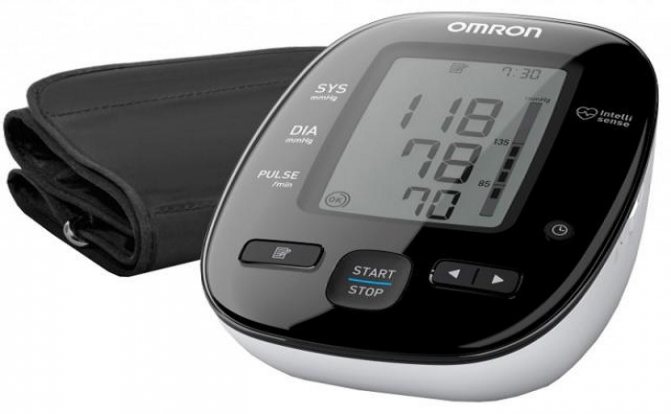Weakness, circles before the eyes or darkening in them, constant fatigue - all this is often found in a mother who has just given birth. But not every woman understands that these are symptoms of hypotension. This can be determined more precisely only with the help of a special device - a tonometer. But even having determined this, a very pressing question arises: how to increase blood pressure during breastfeeding, because in this case, most medications are prohibited.
Signs of low blood pressure
You can distinguish the symptoms of low blood pressure from ordinary physical fatigue by the following signs:
- drowsiness, constant weakness;
- profuse secretion of sweat glands;
- pale complexion;
- sudden mood swings;
- excessively irritable emotional state;
- dependence on changing weather conditions;
- often feel dizzy and nauseous, dizziness when suddenly rising from a sitting position;
- lethargic, as if depressed state;
- During intense physical activity, the heart rate increases significantly;
- absent-minded attention, memory impairment;
- Symptoms such as fainting, loss of appetite and sleep are less common.
Symptoms of hypotension
Signs of low blood pressure (hypotension) in a nursing mother:
- increased drowsiness;
- muscle weakness;
- pale skin;
- mood swings;
- nervousness;
- sensitivity to weather changes;
- dizziness;
- episodes of nausea;
- rapid heartbeat during exercise;
- absent-mindedness;
- apathy.
Hypotensive patients experience fainting due to insufficient blood supply to the brain. Therefore, nursing mothers need to control their blood pressure. Losing consciousness with a baby in your arms is not a good prospect.
Causes of low blood pressure
Low blood pressure during breastfeeding can occur for a number of reasons. But most often arterial hypotension is caused by:
- extensive blood loss, for example, during childbirth. The blood balance may be restored, but its sudden change leads to a decrease in pressure;
- heart disease: any disease related to the cardiovascular system, when there is not enough blood in the arteries or its flow is too small;
- long breaks from professional sports. The heart muscles get used to active training, and in its absence there is a decrease in blood pressure and a slow pulse;
- chronic fatigue syndrome. When nothing makes you happy, depression, stressful situations, constant lack of sleep and overwork arise - all this leads to apathy and can cause hypotension;
- disturbances in the functioning of the endocrine system. Deterioration of the thyroid gland also leads to arterial hypotension;
- injuries in the back and head (fractures, dislocations or pinched joints).
These are just the main causes of the disease. An accurate diagnosis can be made by a therapist who will conduct a comprehensive examination and see the full picture of what is happening. And the symptoms of the disease in some cases are the same.
Normal range
Blood pressure (BP) is the force with which blood flows through the large arteries. It is related to the work of the heart and directly depends on the condition of the blood vessels.

Blood pressure is divided into:
- Systolic, which is noted at maximum contraction of the heart muscle. Normally, its values are from 110 to 130 mmHg.
- Diastolic, which is observed with maximum relaxation of the heart muscle. Normally, its values are from 60 to 90 mmHg.
Reduced values occur at the upper and lower indicators. Each person has his own work pressure with which he feels comfortable.
For example, a woman has always had a blood pressure of 100/60. At a value of 130/90 it will already be considered elevated, and the heart will experience enormous stress. However, this indicator is not critical and, according to the rules, does not require correction. Therefore, before prescribing therapy, it is important to take into account the norms of working blood pressure for a particular person.
The most common recommendations for low blood pressure
If for some reason a trip to the doctor is postponed, and low blood pressure during breastfeeding still worries the mother, then the following measures should be taken:
Normalization of drinking regime
Drinking plenty of fluids will help increase blood volume, and therefore raise blood pressure. For a nursing woman, drinking plenty of fluids is already recommended, and if you have low blood pressure, you should drink even more. The therapist will tell you the exact dosage during the examination. It is worth adding permitted drinks that improve well-being to the volume of fluid consumed:
- green tea, weak;
- lemongrass infusion;
- decoctions with ginseng;
- juice from red apples;
- drinking with the addition of eleutherococcus.

Click here
Diet aimed at treating hypotension during lactation
Since it is better not to use medications when feeding a baby, you can replenish nutrients from food. The diet of a nursing woman with problematic blood pressure should contain ingredients such as:
- Eggs, both chicken and quail, chicken liver, veal, fresh carrots, pure pomegranate and its juice, oatmeal. These products contain substances that increase hemoglobin, and they are also recommended for anemia.
- Sea delicacies, black and red caviar, legumes (namely peas, beans), spinach leaves, greens and celery root. This category is rich in iodine, such products will help replenish its reserves in the body. At the same time, the use of sea or iodized salt will add efficiency.
- Fresh fruits, watermelon, melon. This is a source of additional moisture, beneficial microelements and vitamins. In addition, fruit consumption reduces appetite, which has a beneficial effect on weight loss.
At the same time, do not forget about the effect on the baby - in order to avoid allergies and colic in the newborn, you need to introduce ingredients into the menu of a nursing woman gradually and with great care.
Physical exercise
Physical activity is one of the surest remedies in the fight against low blood pressure. This is not intense professional training, but moderate physical exercise that is allowed during lactation. Daily stress may include:
- walks on foot and at a fairly intense pace;
- cycling both in parks, forest belts within the city, and outside the city;
- running at an easy pace for short distances;
- visiting the pool or swimming in open water in summer;
- exercises with a crossbar;
- bending and bending, strength exercises for the arms - push-ups, a little home workout.
A set of physical activities and fresh air will relieve a nursing woman from negative thoughts, improve metabolism, and provide an opportunity to rest and relax.
Massage and sauna visit
Manual therapy will help speed up blood circulation and solve blood pressure problems. Massage of the toes, cervical region, spine, and back of the head should be considered therapeutic. Such procedures will relieve unnecessary tension and relax the nerve endings. At the same time, correct movements can eliminate joint pain and increase muscle tone.
A visit to the sauna would be a good idea for a young mother. This helps cleanse the body, remove toxins and stabilize blood pressure. The only point is that when visiting a steam room, you should pay attention to the length of your stay, avoid overheating and drink more fluids.
conclusions
A decrease in blood pressure in a woman during breastfeeding is a common occurrence, which is accompanied by characteristic complaints. Traditional correction methods using large amounts of coffee, alcohol, and medications are contraindicated during lactation. Doctors recommend that a nursing mother drink strong tea, a lot of compote or juice for blood pressure. The main ways to correct the condition are proper rest, balanced nutrition and adequate physical activity. The methods will help not only raise blood pressure, but also speed up recovery after childbirth.
The following sources of information were used to prepare the material.
Source
Traditional medicine recipes
In nature, there is a large list of plants that affect blood pressure, but many of them are not recommended during lactation. Herbs are a potential source of allergies for a baby, because components from plants can also pass into the mother’s milk. If a nursing mother periodically faces the question of how to raise her blood pressure, then her menu can include dishes with juniper berries. In case of arterial hypotension, they can be eaten either fresh or used in the preparation of drinks. Just 5 berries can significantly raise blood pressure, so you shouldn’t eat them in larger quantities.
Wormwood has similar properties. The dry plant is infused in boiled water in the proportions of 1 glass of water to two tablespoons of herb until completely cooled and drunk in small sips. Honey will help smooth out the not-too-pleasant taste.
You can also use a medicinal mixture of hops, motherwort and valerian. The plants are taken in equal parts - one tablespoon at a time - poured into a glass of boiling water, filtered after infusion and drunk in small portions several times a day. This healing drink will improve the functioning of the nervous system, restore sleep and heartbeat, and bring blood pressure back to normal.

Herbs, in particular motherwort, can be used to increase blood pressure during breastfeeding, but with great care to avoid harm to the baby.
An even larger list of herbs and plants can be used during lactation, but with caution - angelica, thistle, St. John's wort, hawthorn and others. When consuming healthy decoctions, teas and tinctures, be sure to monitor the baby’s reaction. At the first sign of a negative reaction from the child’s body, it is better to stop taking such folk remedies.
Methods to combat low blood pressure during breastfeeding
Most often, a decrease in pressure (hypotension) does not require correction, since with normal rest and nutrition, indicators are restored independently due to compensatory mechanisms.
Main symptoms of hypotension:
- weakness;
- sleep phase disturbances (nighttime insomnia and pathological daytime sleepiness);
- apathy - lack of desire to do anything, lack of interest in anything;
- diffuse headache;
- visual impairment (double vision, blurred contours);
- dizziness.
Reduced blood pressure disrupts the blood supply to organs and tissues, including the mammary gland, so long-term persistence of these symptoms is accompanied by the risk of a decrease in milk supply.
How can you raise a woman’s blood pressure during lactation?
The period of breastfeeding is characterized by the presence of many restrictions in the mother's lifestyle, therefore traditional methods of blood pressure correction are prohibited.
The safest methods to raise the blood pressure of a nursing mother are presented in the table below.
Increased drinking regimen (up to 2.5 liters per day).
Allowed: compote, juice (natural), uzvar, fruit juice, clean water
A common cause of low blood pressure in women after childbirth is dysfunction of the thyroid gland. In this case, you can raise the values by systematically using iodized salt or iodine preparations (after preliminary consultation and laboratory tests with a doctor).
How to relieve discomfort during hepatitis B due to low blood pressure at home?
Sudden signs of hypotension, which significantly worsen a woman’s condition and complicate child care, require immediate correction.

A nursing mother can raise her blood pressure at home using several methods:
- drink a cup of coffee. One mug of weak coffee a day will not affect the quality of milk (large quantities make it bitter), but will improve the mother’s condition;
- drink a cup of strong black or green tea with sugar;
- use tincture of ginseng or lemongrass (1 tablespoon, dissolved in a glass of water). The products can only be used after consulting a doctor;
- shake your abs (for women during the first month after a caesarean section or complicated childbirth - it is strictly contraindicated).
Drug treatment using pharmacological drugs is carried out only against the background of concomitant pathology and pronounced changes. Often, women must stop breastfeeding during therapy.
Drug treatment
You can also increase your blood pressure with the help of medications. Citramon, Pentalgin, Acepar and other medications are most often used for these purposes. But these medications are not compatible with breastfeeding. Therefore, in difficult situations, when taking medications is necessary and vital for the mother, natural feeding is stopped. Drug treatment is prescribed only by a doctor; you should not resort to self-medication. Depending on the cause and symptoms of the disease, the therapist will select the right drug. It is worth keeping in mind that most of them contain caffeine.
Methods to combat low blood pressure during breastfeeding
Most often, a decrease in pressure (hypotension) does not require correction, since with normal rest and nutrition, indicators are restored independently due to compensatory mechanisms.
Main symptoms of hypotension:
- weakness;
- sleep phase disturbances (nighttime insomnia and pathological daytime sleepiness);
- apathy - lack of desire to do anything, lack of interest in anything;
- diffuse headache;
- visual impairment (double vision, blurred contours);
- dizziness.
Reduced blood pressure disrupts the blood supply to organs and tissues, including the mammary gland, so long-term persistence of these symptoms is accompanied by the risk of a decrease in milk supply.
First aid measures in case of a sharp rise in pressure
If a woman breastfeeding her baby feels unwell, she must:
- Lie down to avoid fainting. If this is not possible in the current situation, sit down or at least find a fulcrum and rest your head.
- Drink a mug of strong sweet tea, eat a sandwich with butter and cheese (this is an option for raising blood sugar levels, even with diabetes).
- Apply light pressure to the temples or massage the cervical vertebrae. This will improve blood circulation.
- Wash your face with cold water, make a compress on your forehead with a dampened towel.
- Take valerian/motherwort tincture - just a couple of drops.
Even if all the methods described helped improve your well-being, you should not delay visiting a therapist. If a nursing mother knows the true cause of such attacks, it will be easier for her to eliminate them. Preventative measures will help avoid pressure surges in the future.
Symptoms
| Pressure | Symptoms |
| Increased |
|
| Decreased |
|
How to measure?

Before measuring blood pressure, you should sit down and relax. Place a cuff on the arm, above the bend of the elbow, fixing the stethoscope on the inside where the large vein passes. Next, we pump up the air with the bulb so that the cuff fits snugly to the arm. Then the air slowly descends, and the tone is listened to through a stethoscope. The first beat shows the systolic pressure, and the last beat shows the dystolic pressure. For ease of use and obtaining accurate data, it is recommended to use an electronic tonometer. This will help avoid data inaccuracies, and the procedure will not bring any difficulties to a person who does not know how to measure blood pressure.










